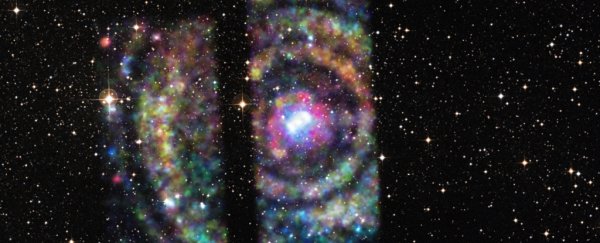Fast radio bursts (FRBs) are one of our Universe's most confounding mysteries - but astronomers may have just figured out the incredible environment where one of the most famous and well-studied FRBs is coming from.
The repeating radio signals from FRB 121102 are likely produced somewhere extreme, like the area around a massive black hole.
FRB 121102 made its first appearance in November 2012, but it took researchers a few years before pinning down its unusual nature. Most fast radio bursts only occur once, which makes them untraceable - but FRB 121102 would go on to repeat.
This afforded a unique opportunity. Fast radio bursts are extremely powerful radio signals, generating as much energy as 500 million suns, but they're also extremely short, lasting just milliseconds.
Because most of them burst once and never return, they are impossible to predict, and impossible to trace. This is one of the main reasons why we don't know what causes them.
But FRB 121102 has proved to be exceptional. In March 2016, researchers announced they'd found 10 other bursts from the same location in archival data. Then in December 2016, 6 bursts were detected from FRB 121102; then 15 more in August 2017.
This allowed researchers to locate the source of these signals - a star-forming region in a dwarf galaxy more than 3 billion light-years from Earth.
And now an international team of researchers has narrowed it down further still, by studying data from radio telescopes that collected the signal - and are more convinced than ever that the source is a neutron star.
But if it is a neutron star, it's in a crazy environment - either very close to a black hole or in a very powerful nebula. This is because of the way the radio signal is "twisted".
The radio signals of FRB 121102 are almost completely polarised. When these polarised signals travel through a magnetic field, they become twisted - the stronger the field, the greater the twist. This is called Faraday rotation, and it allows researchers to learn more about the waves' origin.
In the case of FRB 121102, the twisting of the signals' polarisation is some of the greatest ever observed, which means they had to pass through a very intense magnetic field.
"The only known sources in our galaxy that are twisted as much as FRB 121102 are in the Galactic Centre, which is a dynamic region near a massive black hole. Maybe FRB 121102 is in a similar environment in its host galaxy," said PhD candidate Daniele Michilli of the University of Amsterdam and ASTRON, the Netherlands Institute for Radio Astronomy.
"However, the twisting of the radio bursts could also be explained if the source is located in a powerful nebula or supernova remnant."
This is consistent with the neutron star hypothesis. Neutron stars are one result of massive star undergoing a core-collapse supernova. (If it is greater than a certain mass, the star will turn into a black hole instead.)
They are very small, and very dense, and they emit radio pulses as they spin. A type of neutron star called a magnetar has an extremely strong magnetic field, and these can produce bursts - similar to how the Sun produces solar flares.
This has been proposed as a possible source of the fast radio bursts. However, the most powerful of these flares ever observed has been four orders of magnitude below FRB 121102.
The researchers believe that the source is a regular neutron star, and are hoping to find out more.
"We are continuing to monitor how the properties of the bursts change with time," said Jason Hessels from the University of Amsterdam and ASTRON.
"With these observations we hope to distinguish between the two competing hypotheses of a neutron star either near a black hole or embedded in a powerful nebula."
Meanwhile, we still don't have a lead on the dozens of other fast radio bursts that have been observed. And, because they don't repeat - FRB 121102 is the only repeater - it's very possible that FRB 121102 is unique in its source, and the others emanate from different sources.
The researchers presented their findings at the 231st meeting of the American Astronomical Society, and their paper has been published in the journal Nature.
